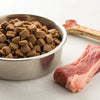Can I Mix Raw Dog Food with Dry Food? Exploring the Benefits and Best Practices
- Houndsy
Table of Contents
- Introduction
- Understanding Raw and Dry Dog Food
- The Benefits of Mixing Raw and Dry Dog Food
- Transitioning to a Mixed Diet
- Addressing Common Concerns and Myths
- Practical Tips for Mixing Raw and Dry Dog Food
- Conclusion
Introduction
As pet owners, we often wonder how to provide the best nutrition for our furry companions. One pressing question that many of us grapple with is: can I mix raw dog food with dry food? This query is not just about dietary preferences; it encompasses concerns about health, digestion, and the overall well-being of our pets. Did you know that a significant number of dog owners are increasingly turning to a mixed feeding approach, blending raw and dry food to create a more balanced diet?
In this blog, we will delve into the intricacies of mixing raw dog food with dry kibble, examining the potential benefits and addressing common misconceptions. By the end of this post, you will have a comprehensive understanding of how to safely integrate raw and kibble into your dog’s diet, ensuring that every meal contributes to a healthier, happier pup.
We will cover various aspects of this topic, including the nutritional benefits of mixing raw and dry food, how to successfully transition your dog to this feeding method, and the ideal ratios to maintain for optimal health. Moreover, we will address potential concerns about digestion and food safety, equipping you with the knowledge you need to make informed decisions for your pet’s diet.
So, let’s embark on this journey to discover how mixing raw dog food with dry kibble can enhance your dog's feeding experience, improve their health, and perhaps even bring a little more joy to mealtime!
Understanding Raw and Dry Dog Food
Before we dive into the benefits and methods of mixing raw and dry dog food, it’s essential to understand what each type of food entails.
What is Raw Dog Food?
Raw dog food, often referred to as a raw or "BARF" (Biologically Appropriate Raw Food) diet, consists of uncooked meat, bones, fruits, and vegetables. Proponents of raw feeding argue that it mimics the natural diet of dogs, which evolved from wolves that primarily consumed raw prey. This type of diet is believed to provide several advantages, including:
- High Nutritional Value: Raw food is packed with nutrients, enzymes, and antioxidants that can promote better health and vitality.
- Improved Digestion: Many pet owners report that their dogs have improved digestion and smaller, less odorous stools when fed a raw diet.
- Healthier Skin and Coat: Raw diets often lead to shinier coats and healthier skin due to the high levels of omega fatty acids found in meat and fish.
What is Dry Dog Food (Kibble)?
Dry dog food, or kibble, is a commercially prepared dog food that is cooked and processed. Kibble typically consists of grains, proteins, fats, vitamins, and minerals. While it is convenient and shelf-stable, the nutritional quality can vary significantly based on the brand and ingredients used. Key aspects of dry dog food include:
- Convenience: Kibble is easy to store, measure, and serve, making it a popular choice for busy pet owners.
- Cost-Effectiveness: Generally, dry dog food is more affordable than raw diets, making it accessible for a wide range of pet owners.
- Preservation: Kibble has a longer shelf life than raw food, reducing the risk of spoilage.
The Benefits of Mixing Raw and Dry Dog Food
Now that we understand the basics of raw and dry dog foods, let’s explore why mixing them can be beneficial for your dog.
Enhanced Nutritional Balance
Combining raw and dry dog food can create a more balanced diet. Raw food is rich in protein and moisture, while kibble often contains necessary carbohydrates and fiber. This combination can help:
- Provide a Variety of Nutrients: Mixing the two types of food ensures that your dog receives a broader spectrum of essential nutrients, including vitamins, minerals, and healthy fats.
- Promote Satiety: The combination of protein from raw food and fiber from kibble can help keep your dog feeling full and satisfied.
Improved Digestion
One of the primary concerns pet owners have about mixing raw and kibble is the potential for digestive issues. However, many dogs can handle a mixed diet quite well. Here’s why:
- Adaptation of Gut Bacteria: Dogs have a robust digestive system that can adapt to various food types. Gradually introducing raw food into their diet allows their gut bacteria to adjust, minimizing the risk of gastrointestinal upset.
- Enzyme Production: Dogs can produce the necessary enzymes to digest both raw and dry food. The key is to ensure that any dietary changes are made gradually to avoid shocking their system.
Convenience and Cost-Effectiveness
For many pet owners, the idea of feeding only raw food can be daunting due to cost and preparation time. Mixing raw and dry food offers a practical solution:
- Flexibility: You can choose how much raw vs. kibble to serve based on your budget and schedule. For instance, you may opt for kibble during busy mornings and raw food in the evenings when you have more time.
- Stretching Your Budget: Incorporating kibble into your dog’s diet can help alleviate the financial burden of a fully raw diet while still providing the benefits of fresh food.
Transitioning to a Mixed Diet
Transitioning your dog to a mixed feeding regimen should be done thoughtfully to ensure a smooth adjustment. Here are steps to consider:
Gradual Introduction
When introducing raw food into your dog’s diet, it’s crucial to do so gradually. A sudden change can lead to digestive upset. Start by:
- Mixing Small Amounts: Begin with a small proportion of raw food mixed with the kibble. For example, you might start with a 25% raw to 75% kibble ratio.
- Monitoring Reactions: Keep an eye on your dog’s reaction to the new diet. Look for signs of digestive distress, such as vomiting or diarrhea. If these occur, revert to the previous diet and reintroduce raw food more slowly.
- Gradually Increasing Raw Portions: Over the course of several days or weeks, you can gradually increase the ratio of raw food until you reach your desired balance.
Consider Dietary Needs
Each dog is unique, and their dietary requirements can vary based on factors such as age, breed, activity level, and health conditions. It’s crucial to consult with your veterinarian to determine the best ratio of raw to kibble for your dog. Some common ratios include:
- 50/50 Mix: This is a popular ratio for many pet owners looking for a balanced diet.
- 75% Raw to 25% Kibble: For those who want to prioritize raw food but still incorporate kibble for convenience or cost.
- 25% Raw to 75% Kibble: Ideal for dogs transitioning from a kibble-only diet or for those whose owners want to maintain a primarily dry diet.
Addressing Common Concerns and Myths
Despite the many benefits of mixing raw and dry dog food, several myths and concerns persist. Let’s address some of the most common ones.
Myth 1: Raw and Kibble Digest Differently
One of the most prevalent myths is that raw and kibble digest at different rates, leading to potential digestive issues. However, research indicates that:
- Dogs are equipped to handle a variety of foods. Their digestive systems produce the necessary enzymes and acids to break down protein, fats, and carbohydrates, regardless of their source.
- The key to preventing digestive upset lies in the gradual introduction of new foods, not the inherent differences between raw and kibble.
Myth 2: Mixing Causes Stomach Upset
Many pet owners worry that mixing raw and kibble will lead to an upset stomach. While it’s true that sudden dietary changes can cause gastrointestinal issues, a well-planned transition can prevent this:
- Gradually mixing the two types of food allows your dog’s digestive system to adapt, reducing the likelihood of stomach upset.
- Always monitor your dog’s response to dietary changes and adjust accordingly.
Myth 3: Risk of Bad Bacteria
Another concern about mixing raw and dry food is the potential for harmful bacteria growth. While raw food can contain bacteria, healthy dogs have robust immune systems that can handle it. To reduce risk:
- Choose Quality Ingredients: Always opt for high-quality raw and dry food. Ensure that the raw food is sourced from reputable suppliers and handled properly.
- Practice Good Hygiene: Wash your hands and clean feeding bowls thoroughly after serving raw food to minimize cross-contamination.
Practical Tips for Mixing Raw and Dry Dog Food
Now that we understand the benefits and address the myths surrounding mixed feeding, here are some practical tips for successfully integrating raw food into your dog’s diet:
Use Raw as a Topper
One straightforward way to incorporate raw food into your dog’s meals is by using it as a topper for kibble. This method adds flavor and nutrition without requiring a complete overhaul of their diet.
Prepare Meals in Batches
If you’re concerned about time constraints, consider preparing meals in batches. You can mix raw food with kibble in advance and store it in the fridge, making mealtime convenient and efficient.
Monitor Weight and Health
As you transition your dog to a mixed diet, keep an eye on their weight and overall health. Adjust the ratios as needed to ensure they maintain a healthy weight and receive adequate nutrition.
Conclusion
Mixing raw dog food with dry food is not only a feasible option but can also provide numerous benefits for your furry friend. By creating a balanced diet that incorporates the best of both worlds, you can enhance your dog's overall health, improve digestion, and make mealtime more enjoyable. Remember to transition gradually, monitor your dog's reactions, and consult with your veterinarian to find the best ratio for your pet's unique needs.
At Houndsy, we understand the importance of creating a convenient and aesthetically pleasing feeding experience. Our flagship product, the Houndsy Kibble Dispenser, is designed to simplify your dog feeding routine while maintaining style and functionality. With features like precise portion control and a sleek design that complements your home decor, we aim to elevate the everyday experience of pet owners.
Let’s make mealtime a delightful ritual for both you and your dog, ensuring that every bowl is filled with love and nutrition!
FAQ
Can I mix raw dog food with dry food?
Yes, you can safely mix raw dog food with dry food as long as you gradually introduce the raw food and monitor your dog’s reaction.
What are the benefits of mixing raw and kibble?
Mixing raw and kibble can enhance nutritional balance, improve digestion, and provide convenience and cost-effectiveness.
How do I transition my dog to a mixed diet?
Start by mixing small amounts of raw food with kibble and gradually increase the raw portion over several days or weeks.
Will mixing raw and kibble cause digestive problems?
Sudden dietary changes can cause digestive upset, but a gradual transition allows your dog’s digestive system to adapt.
What ratio of raw to kibble should I use?
The ideal ratio depends on your dog’s specific needs. Common ratios are 50/50, 75% raw to 25% kibble, or 25% raw to 75% kibble. Consult your veterinarian for personalized guidance.












